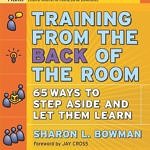PowerPoint 3.0 Revisited (with a Give-Away)

About a year ago I wrote a blog post titled: “PowerPoint 3.0 (and a Free Give-Away).” I’m reposting that blog here because I’ve gotten email questions regarding the use of slides. Be sure to check out the resources at the end of this post and pick up the free give-away, if you haven’t already.
I know some trainers who have totally let go of PowerPoint in face-to-face instruction – they don’t use ANY slides at all! They have recreated their content delivery strategies so that the focus is entirely on the learner and not on a slide screen.
 Here are few of the steps they took (and you can, too) to move in the direction of “slideless” classroom instruction:
Here are few of the steps they took (and you can, too) to move in the direction of “slideless” classroom instruction:
1. Begin with the premise that PowerPoint doesn’t exist (there was a time when it didn’t!). Or just say to yourself that you don’t have access to a computer or LCD projector and screen.
2. Start thinking of ways to teach, other than putting all your content on slides and reading the slides to the learners. Choose instructional strategies in which learners must be actively involved in order to learn the information you’re presenting.
3. Let go of straight lecture (i.e. you talk, they listen – ALL the time) and choose a variety of strategies in which you talk for a bit (say, 10-minutes) and then the learners must DO something with what you’ve just taught: discuss/summarize the content, answer questions, write on wall charts, play a short flashcard game, read and highlight part of a handout, do a self-correcting worksheet on their own, create content-related metaphors, etc.
4. Use engagement strategies to introduce concepts, to reinforce what you’ve taught during your (very) short verbal segments of instruction, and to summarize information.
5. When you’re ready to take this next step (truth be told, I haven’t yet done this, but I’m moving in this direction), create a full-blown engagement strategy that teaches what learners need to be able to remember and use after the class or training is over. This strategy could be a branching scenario (see Cathy Moore’s outstanding blog about action-mapped learning), or an activity such as the ones Scrum trainers and Agile coaches use, in which the learning is embedded in the activity (examples: a team building activity to teach team building skills, a problem-based discussion to teach a problem-solving procedure, a computer activity to teach data entry). In other words, you begin “to use the thing to teach the thing.”
6. Finally, decide which PowerPoint level you’re on (see below) and strive to go to the next step:
PowerPoint 1.0: You put your lecture notes on a slide and read them aloud while learners sit and listen. This is NOT about learning; it’s about lecturing.
PowerPoint 2.0: You use slides as a learning tool that will help learners remember and use the content you’re teaching. If you’re not already doing this, the following three resources will help you move to this step:
Slides About PowerPoint – Scroll down the page, view one or two short, image-rich slide presentations that interest you, then begin to recreate your slide set using ideas from these presentations.
“6 Ways to Quit Bullet Points with Style” by Podium Wisdom – My blog post about a great, stand-alone slide presentation with lots of useful slide ideas.
A FREE Giveaway – Click on the button below to receive content you can download and share with other PowerPoint users:
PowerPoint 3.0: You get rid of slides entirely and use a variety of other strategies to teach your content. This is the direction you and I are headed, if we truly want our face-to-face classes and training to be active, brain-based, useful, and totally unforgettable!
******************************
 If you are interested in attending a brain-based, highly-experiential, 2-day “Training from the BACK of the Room” class, check out the global calendar of classes on either the What’s New? or Training Events pages.
If you are interested in attending a brain-based, highly-experiential, 2-day “Training from the BACK of the Room” class, check out the global calendar of classes on either the What’s New? or Training Events pages.